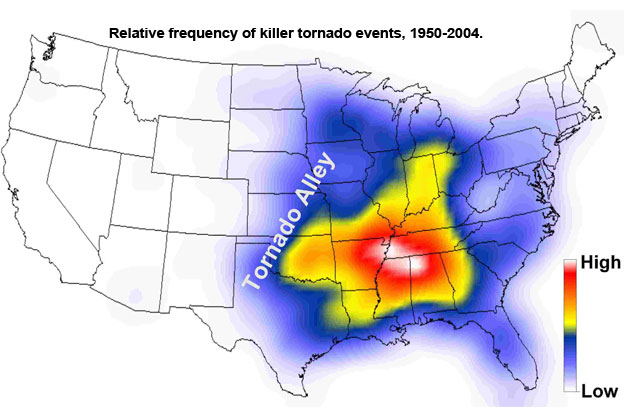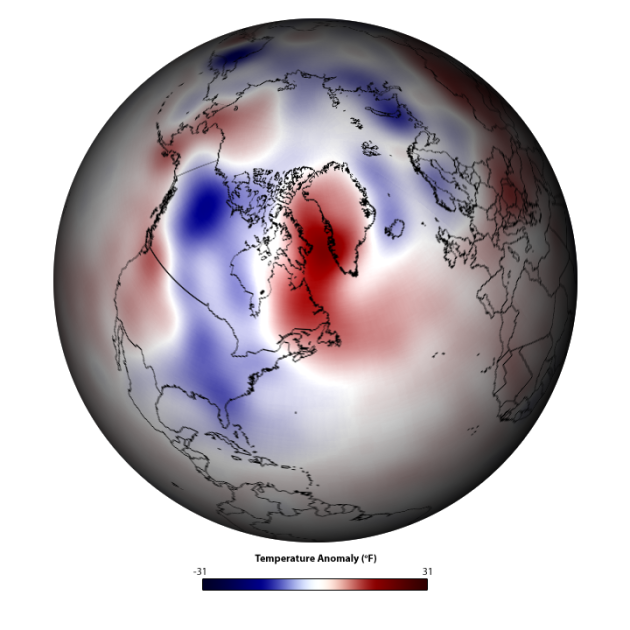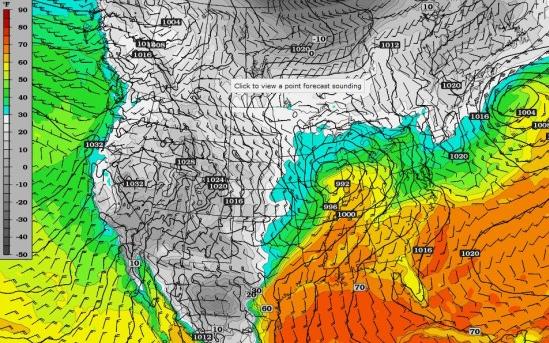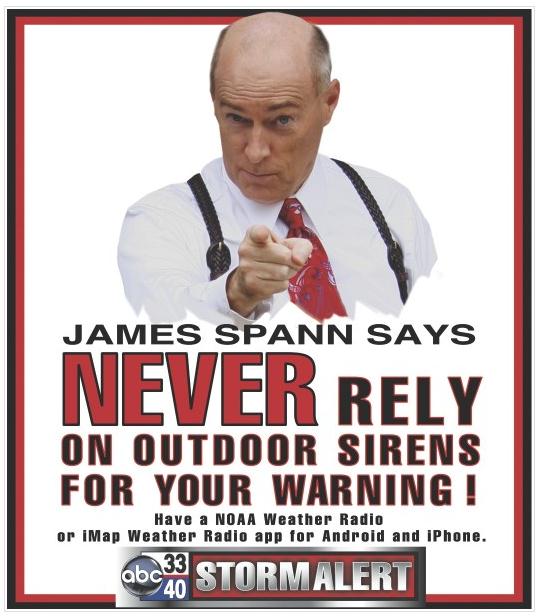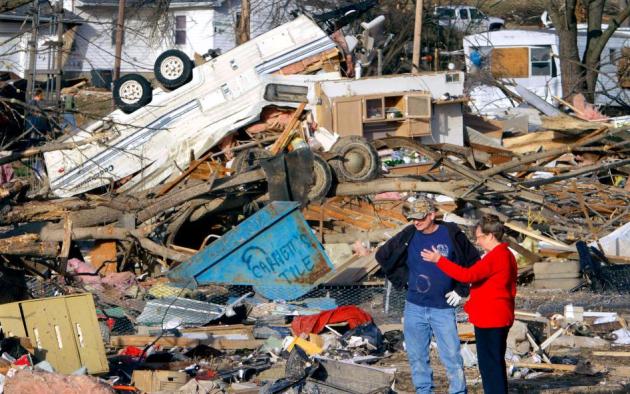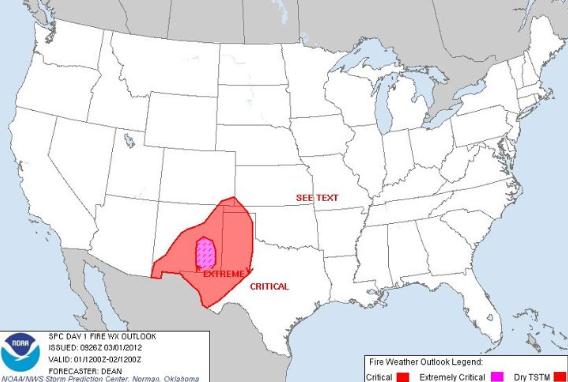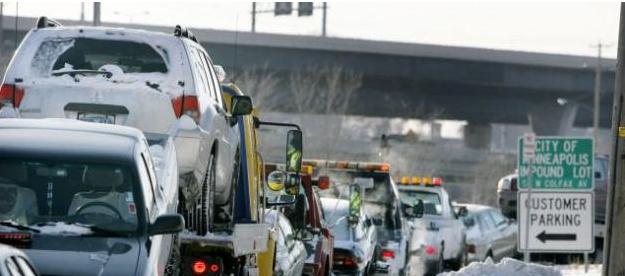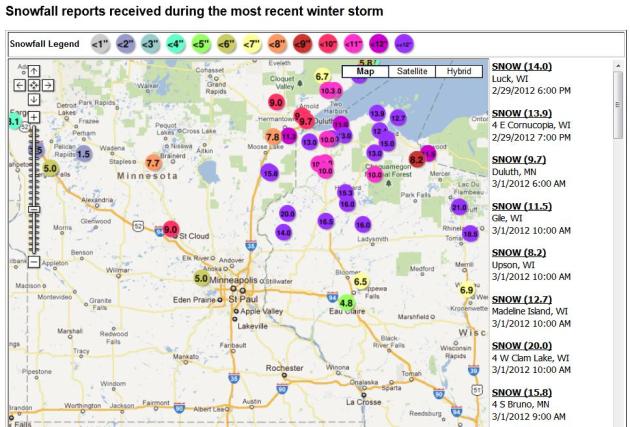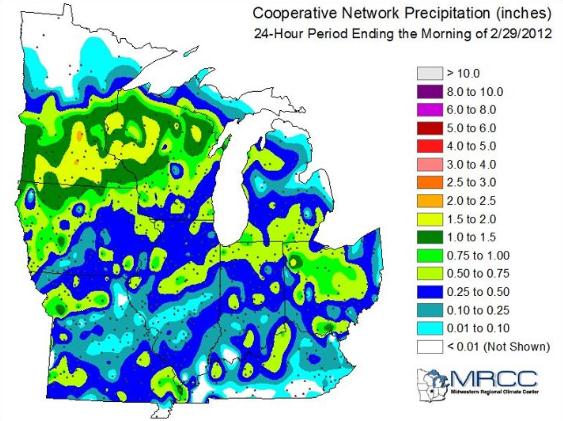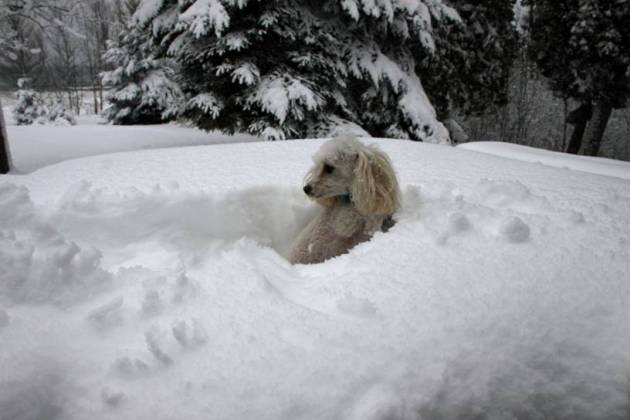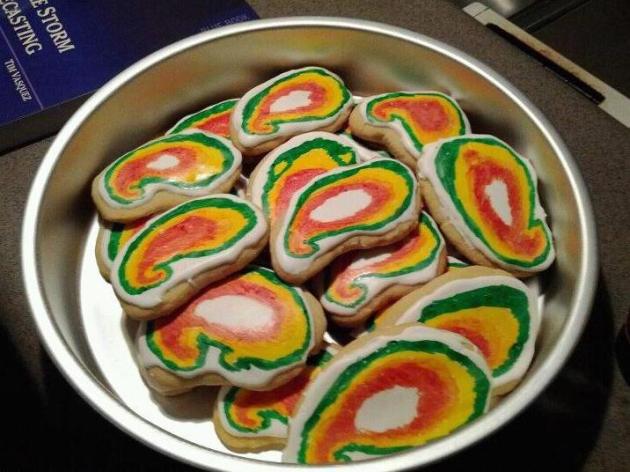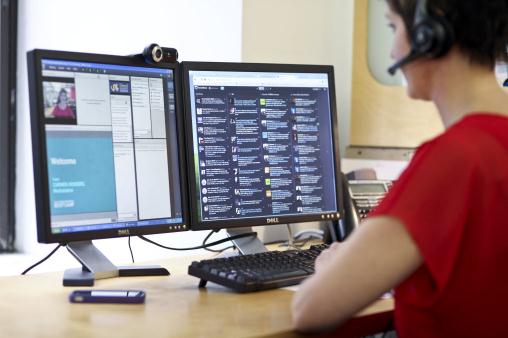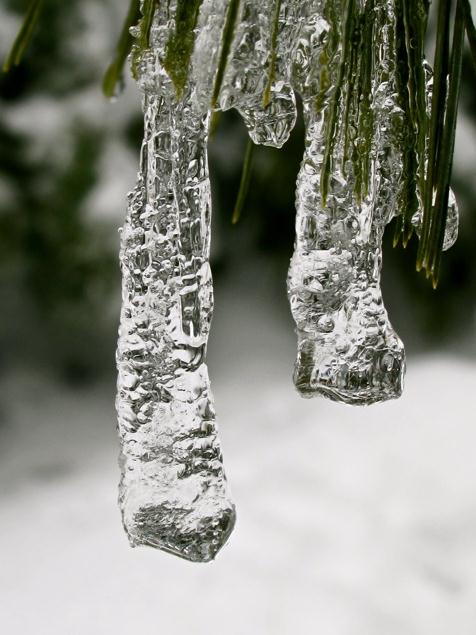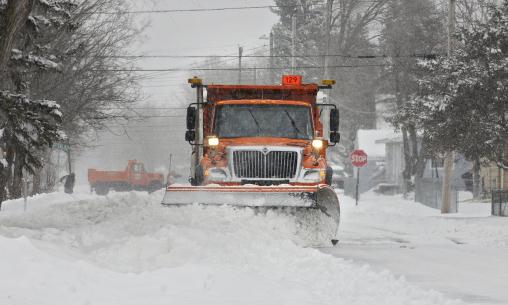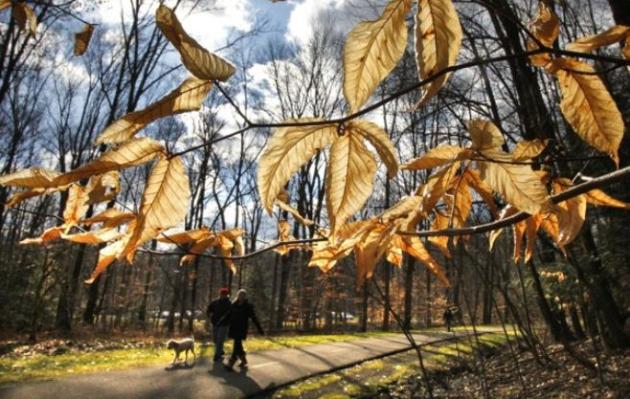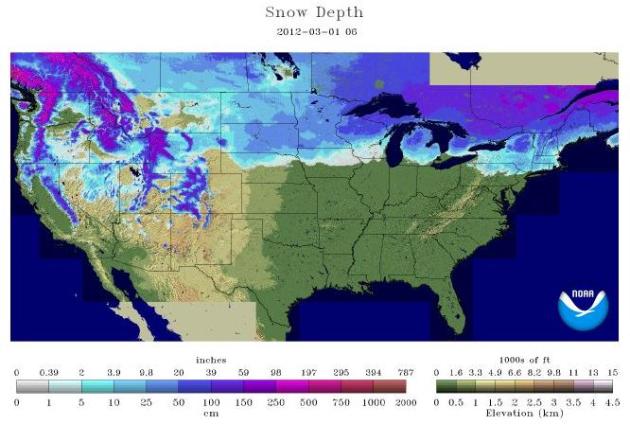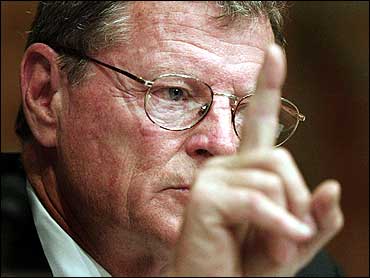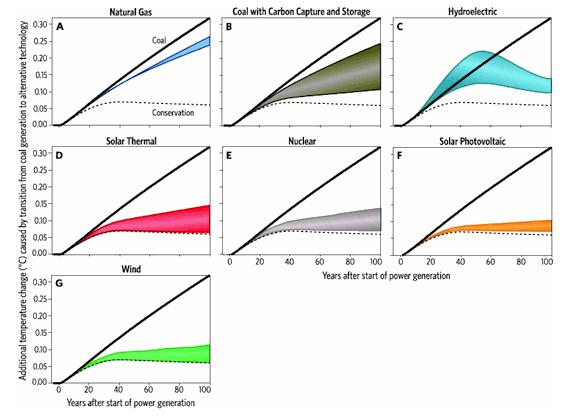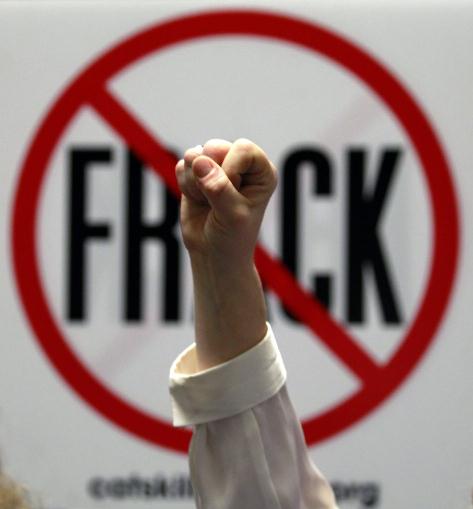36.2% of America (lower 48 states) covered in snow as of March 1, 2012.
19.2% of America covered in snow on February 1, 2012. Source:
NOAA.
80 F. high at Raleigh/Durham Thursday. Normal high for March 1 is 59 F.
50 days above 40 F. in Chicago since December 1. 19.5" snow, no days below zero. Coldest temp: 5 F. Source: Bill Bellis, Hootsuite.
Major Tornado Outbreak Today for the nation's midsection, Ohio Valley and Mid South, possibly rivaling the deadly outbreak of May, 2011. Some are comparing this to the "Super Outbreak" of 1974, when 148 tornadoes touched down in 13 states.
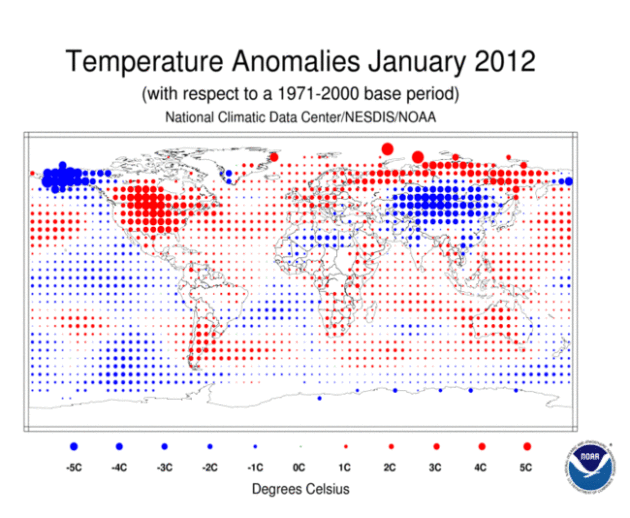 January: 19th Warmest Worldwide
January: 19th Warmest Worldwide. NOAA's NCDC division has more
details.
"
However, most climate models predict more positive AOs (like this winter) in the future. The IPCC hypothesizes that this could be because a warmer lower atmosphere and a cooler upper atmosphere, both products of human-produced greenhouse gases, cause the polar vortex to strengthen. Stronger polar winds mean cold Arctic air stays up north. That equals more bad snow conditions for the U.S. even without the influence of a warmer planet." - from an article at Huffington Post below. Graphic courtesy of
Real Science.
“
If there is a dramatic loss of Arctic sea ice, the westerly winds that blow across the North Pacific and North Atlantic oceans are weakened,” lead author Jiping Liu, a senior research scientist at the Georgia Institute of Technology, told Climatewire. “This means we will have a wavier jet stream.” The loss of ice and warmer temperatures mean that there is much more evaporation from the Arctic Ocean, leading to a higher moisture content in the polar air that is pulled south. That means that intense snowfall is more likely, especially as the polar air collides with warm, moist air from the south. In 1999, Kevin Trenberth explained how global warming would lead to more intense precipitation events, including snow storms." - from an article from Think Progress and Renew Economy; details below.
"
Along with the steady decline (3.2 percent per decade) in overall Arctic sea ice extent, a new NASA study shows that the oldest and thickest multi-year ice is melting at a much faster pace — about 15 percent per decade — than the thin ice that forms anew each year." - from an article at Summit County Citizens Voice; details below.
"One major issue, she said, is that when we text, email or post to a social networking site, we’re able to project ourselves as we want to be seen. “We get to edit, we get to delete, and that means we get to retouch.” Inversely, Turkle notes that a face-to-face conversation “takes place in real time and you can’t control what you’re going to say.” - from a mashable.com article below.
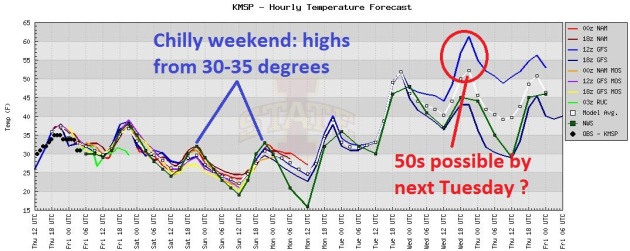 Seasonably Chilly Weekend: Hints Of April Next Week?
Seasonably Chilly Weekend: Hints Of April Next Week? Long-range guidance shows 40s, even some 50s possible by the middle of next week. Like snow? Get out this weekend and make the most of it, because (at least in the metro) our snow will be gone by Tuesday of next week.
Graphic above courtesy of Iowa State's meteorology department. Go Cyclones!
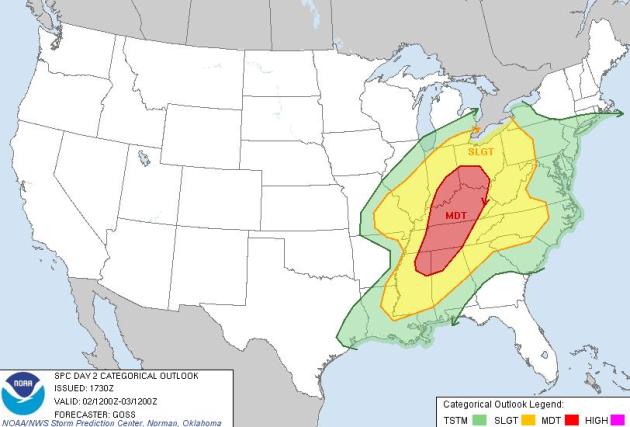 Significant Tornado Potential
Significant Tornado Potential. Much of the Ohio Valley and Mid South is under a "moderate risk" of severe storms. There's a chance this may be upgraded to a (very rare)
"high risk" later today. More from
SPC, NOAA's Storm Prediction Center:
"WITH STORM MODE LIKELY TO BECOME A MIX OF SUPERCELLS AND COMPLEX LINE SEGMENTS...THREATS FOR BOTH DAMAGING WINDS AND SEVERAL TORNADOES APPEARS EVIDENT...ACCOMPANYING THE LIKELIHOOD FOR LARGE HAIL. A COUPLE OF STRONG TORNADOES WILL ALSO BE POSSIBLE -- MAINLY DURING THE MID TO LATE AFTERNOON HOURS IN AND NEAR THE MODERATE RISK AREA."
Major Severe Weather Episode Looking More Likely For Ohio Valley And Mid South. The maps are not looking good, in fact some meteorologists (I admire and trust) are comparing some of the parameters to the "
Super-Outbreak of 1974", when over 120 tornadoes touched down in one 24 hour period from the USA into Ontario, Canada. That's the
unprecedented severe weather event that got my attention as an aspiring 16 year old weather nerd. It was beyond my comprehension that so many (large/violent/deadly) tornadoes could touch down on a single day: April 3, 1974. Here are some details from a post by the
Northern Illinois Storm Chaser site: "
Our expectation is that convection will initiate by early afternoon southeast of the favored triple point, with the best chance for a chase able tornadic supercell INVO of the warm front, southeast of the surface low, across S IL or far SE MO (i.e., K1H2 – KFWA). A massive QLCS is likely to erupt by late afternoon and early evening, extending from SE IL into SC AL and points ENE. All modes of severe weather are possible, though the threat for tornadic supercells, especially those embedded within QLCS structures, will remain a bona fide threat given the directional shear profiles found across the region. Wind damage is also a threat, along with some large hail. Given the impressive speed shear profiles, some substantial wind damage appears likely; consequently, assuming that the instability profiles materialize, and it looks as if they will, this is going to be a very dangerous situation for anyone residing in the middle and lower Mississippi River valleys, extending eastward across the Ohio River Valley."
Sound Advice. I couldn't agree more - never rely on the emergency outdoor sirens. They were designed for outdoor use only. The more sources of warning information, the better: NOAA Weather Radio, local TV, radio, e-mail, apps, etc. Alabama weather legend James Spann has more good advice in
his blog.
Potentially Violent Friday. The dark-red shaded area indicates an 80-100% probability of thunderstorms later today - many will be severe; some capable of large hail, damaging straight-line winds and potentially large, violent, long-lasting tornadoes. More from
NOAA's Environmental Visualization Laboratory.
Severe Storms And Tornadoes Tear Through The Heartland. Leap Day, 2012 will never be forgotten in the town of Harrisburg, Illinois.
Pjstar.com has some unforgettable photos of the carnage left behind from EF-4 tornadoes: "
Leap Day was not a good one for thousands of people in the Midwest and Southern United States as severe storms and tornadoes left a trail of destruction in Illinois, Missouri, Kansas, Arkansas, Oklahoma, Kentucky, and Tennessee. Waves of strong storms devastated small communities and damaged the country music resort town of Branson, Missouri. But none faced the wrath of Mother Nature like the southern Illinois town of Harrisburg. A massive 200-yard wide EF4 twister, the second worst type, smashed into the small town of 9,000 with 170 mph winds, killing 6 and injuring hundreds more."
Photo credit above: "
People try to salvage what they can after a tornado destroyed homes in their neighborhood Wednesday, Feb. 29, 2012, in Harrisburg, Ill. The tornado that blasted Harrisburg, killing six, was an EF4, the second-highest rating given to twisters based on damage. Scientists said it was 200 yards wide with winds up to 170 mph. (AP Photo/Seth Perlman)."
Critical Fire Threat. From NOAA's
Facebook page: "
An extremely critical fire weather threat is forecast today across parts of southeastern New Mexico surrounded by a critical fire weather threat over much of the southern High Plains."
A Tale Of Tow Cities (Mpls/St. Paul) After Recent Snowfall. The
Star Tribune's Bill McAuliffe takes a look at how both metro areas approached out recent mega-snow (a whopping 2.8"), just enough snow to torment some poor residents who parked in the wrong spot at the wrong time: "
Owners of 1,085 vehicles felt the pain of the season's first snow emergency in St. Paul Wednesday and Thursday, getting their vehicles towed for violating parking restrictions. They were some of the 3,890 who also received tickets. The totals from Minneapolis: zero, and zero. That's because Minneapolis did not declare a snow emergency, pointing out another of the subtle ways in which the Twin Cities can differ. Snow emergencies can launch in St. Paul when 3 inches or more of snow falls, but the threshold in Minneapolis is 4. The official snowfall in the Twin Cities from Tuesday night into Wednesday, measured at Minneapolis-St. Paul International Airport, was 2.8."
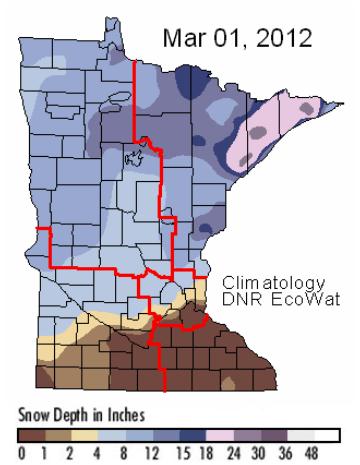 Most Snow Of The Winter - In Meteorological Spring?
Most Snow Of The Winter - In Meteorological Spring? As far as the atmosphere is concerned, Thursday marked the first day of (true) spring, "meteorological spring". What is historically the 90 coldest day stretch of the winter ended on February 29. So it's more than a bit odd that the map above displays the most snow we've seen during the entire winter season. I stand by my prediction that this upcoming weekend will be the best weekend of the "winter" for snowmobiling and cross country skiing up north. More trail details from the Minnesota DNR
here.
Significant Snow Up North. The local NWS office has a
great URL (on a zoomable Google map) that shows how much snow is on the ground. There's no doubt in my mind that this weekend may be the last chance to zip north and check out some great snow conditions. If the forecast verifies and we do see 40s (and even some 50s) next week this snow will quickly turn to slop, and be mostly-gone within a week. Don't procrastinate...
Much-Needed Precipitation. It wasn't nearly enough snow for winter enthusiasts (at least in the Twin Cities metro area), but the storm that hit Tuesday-Wednesday did dump significant precipitation on much of central and southern Minnesota, some 1-2" amounts. It doesn't erase the drought, since much of this moisture will eventually run off of frozen ground - but it helped a little. More from the Twin Cities NWS: "
The winter storm on February 28th and 29th brought much needed precipitation to the region. The area has been in a drought since late summer 2011. Heres a map showing 24 hour precipitation amounts, ending around 7AM on February 29th. More precipitation fell in the Twin Cities from this storm than has fallen in any one event since August 16, 2011. In addition, February was the first month since July of 2011 that the precipitation was above normal in the Twin Cities."
It's Official - The Snow Was "One Poodle Deep". Thanks to my friend and fellow weather enthusiast Pete Schenck, who lives up in Herbster, Wisconsin, on the banks of mighty Lake Superior, where a cool 12" snow piled up from Wednesday's storm.

 The Better End Of Today's Storm
The Better End Of Today's Storm. Yes, snow can be disruptive, but at least it won't sweep your home off the foundation. Chicago and Milwaukee may pick up 6-8" of snow today, well over a foot for northern Lower Michigan, just a coating of snow expected for parts of central and northern Minnesota looking out 84 hours. NAM forecast above courtesy of NOAA and WeatherCaster.
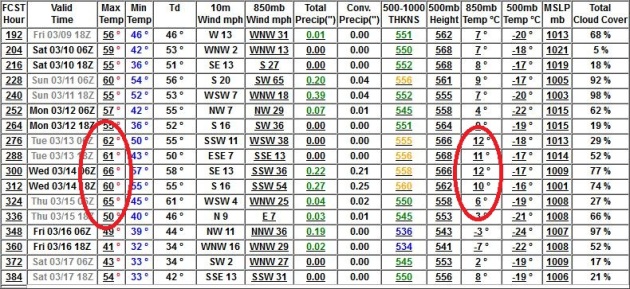 70 By Mid March?
70 By Mid March? At this point nothing would surprise me - it's been a winter of shock and awe. The GFS is showing highs in the mid 60s by March 14-15, with 850 mb temperatures reaching +12 C. Then again the GFS has been especially erratic in recent months, so my confidence level is lower than usual. Then again, our weather has been on fast-forward since late January. No more subzero weather (only 3 nights below zero all winter), so 60s in mid March makes sense. We'll see.
"Hook Echo Cookies?" O.K. This may not be the best day to be sharing this photo, but there are a lot of storm chasers out there that just can't get enough of hook echoes. Now I've officially seen everything. Thanks to Susie Martin for sharing this sweet pic.
Is Social Media Actually Making Us Less Connected? An article at
mashable.com caught my eye: "
LONG BEACH, Calif. – Checking email during meetings. Shopping on your smartphone in the middle of class. Texting at funerals. These are a few of the examples that MIT professor Sherry Turkle offered during her TEDTalk on Thursday, in which she argued that “technology is taking us places we don’t want to go.” Turkle, a psychologist who leads MIT’s Initiative on Technology and Self, believes that while our constant communication and social media engagement does make us more connected, it’s coming at the sacrifice of real conversation. And she thinks that will have some serious consequences for our relationships, our self-perceptions and our emotions."
Photo credit above: "
Carmen Scheidel, of Mediabistro, conducts an online class as part of a social media marketing boot camp in New York, Feb. 16, 2012. For midcareer executives, knowing how to use Twitter, update your timeline on Facebook, pin on Pinterest, check in on Foursquare and upload images on Instagram are among the digital skills some employers expect in a job candidate. (Fred R. Conrad/The New York Times)."
Your Life, Broadcast Live.
The New York Times (subscription may be required) details an amazing new innovation (threat?) that allows you to wear a device that streams live video and audio from wherever you might happen to be, into the ubiqitous "cloud". Oh boy - we're not safe anywhere now. "
When Looxcie, the tiny video camera that fits over the ear, came out in 2010, it gave navel gazers an opportunity to record and share the minutiae of their daily lives. Looxcie records in a continuous five-hour loop, allowing users to capture events in their lives, both unexpected and mundane, without lugging around a video camera. An Instant Clip button on the gadget lets videographers send a clip of the last 30 seconds to a social network with a single click."
8 Qualities Of Remarkable Employees. This article from inc.com and
LinkedIn.com caught my eye: "
Great employees are reliable, dependable, proactive, diligent, great leaders and great followers... they possess a wide range of easily-defined—but hard to find—qualities. A few hit the next level. Some employees are remarkable, possessing qualities that may not appear on performance appraisals but nonetheless make a major impact on performance. Here are eight qualities of remarkable employees:
1. They ignore job descriptions. The smaller the company, the more important it is that employees can think on their feet, adapt quickly to shifting priorities, and do whatever it takes, regardless of role or position, to get things done."
Freezing Rain. This terrific example of freezing rain, rain freezing on contact with cold surfaces (sometimes called glaze ice) was shot by Tricia Frostad in Chanhassen.
Dreaming Of Spring Break. Here's a photo of one very contented family down in Boca Grande, on a barrier island south of Sarasota, Florida.
More Warm Records Than Cold Records. Last year there were nearly 3 times more record highs than record lows across the USA. Source: CapitalClimate and
Think Progress.
Writing On The Wall
No, this hasn't been your grandfather's winter. And we shouldn't be too shocked: NASA says 10 of the 11 warmest years on record have taken place since 2000.
A new poll suggest nearly 2 out of 3 Americans now believe that climate change is real. It may have little to do with believing the science and more to do with looking out the window. Some are mistaking "weather" for "climate", but there is no mistaking an apparent uptick in extreme weather.
A tornado outbreak over the nation's midsection later today may rival major outbreaks, like the "Super Outbreak" of 1974. La Nina springs are often more severe than normal.
Ironically, a loss of arctic sea ice may be increasing the potential for heavier U.S. winter snows, in spite of warming winters. Details on my blog.
My weatherwise friend over at
Minneapolis/St. Paul Magazine, Adam Platt, writes: "I have been able to see grass in my backyard all but about 5 days before Thanksgiving. This is truly amazing. And I am not complaining." You're not alone.
A cool, flakey weekend gives way to an April fling; 50s possible by Tuesday. More bare lawns within 96 hours.
Climate Stories...
Global Warming's Critical Role In "Snowpocalypse Winters". Australia's
Renew Economy has the story: "
Scientists have tied the rapid decline of Arctic sea ice, caused by global warming pollution, to the recent extreme winters that hit the United States last year and Europe this year. In “Impact of declining Arctic sea ice on winter snowfall,” a new report published by the Proceedings of the National Academy of Sciences, researchers find that the loss of polar ice has changed atmospheric circulation and increased atmospheric water vapor, driving the popularly-dubbed “snowpocalypse” conditions: “We conclude that the recent decline of Arctic sea ice has played a critical role in recent cold and snowy winters.”
Photo credit above: "St. Cloud, Minn., city snowplows clear city streets of about 8 inches of wet, heavy snow Wednesday, Feb. 29, 2012. (AP Photos/The St. Cloud Times, Dave Schwarz)."
Global Warming: Thick, Multi-year Arctic Ice Melting Faster. Some vaguely troubling developments documented by the
Summit County Citizen's Voice: "
Along with the steady decline (3.2 percent per decade) in overall Arctic sea ice extent, a new NASA study shows that the oldest and thickest multi-year ice is melting at a much faster pace — about 15 percent per decade — than the thin ice that forms anew each year. The rapid decline of older ice makes the Arctic Ocean’s floating ice cap even more vulnerable to further decline in the summer, according to Joey Comiso, a senior scientist at NASA Goddard Space Flight Center. “The average thickness of the Arctic sea ice cover is declining because it is rapidly losing its thick component, the multi-year ice. At the same time, the surface temperature in the Arctic is going up, which results in a shorter ice-forming season,” Comiso said. “It would take a persistent cold spell for most multi-year sea ice and other ice types to grow thick enough in the winter to survive the summer melt season and reverse the trend.”
Graphic credit above: "The bright white central mass shows the perennial sea ice while the larger light blue area shows the full extent of the winter sea ice including the average annual sea ice during the months of November, December and January. The data shown here were compiled by NASA senior research scientist Josefino Comiso from NASA's Nimbus-7 satellite and the U.S. Department of Defense's Defense Meteorological Satellite Program. Credit: NASA/Goddard Scientific Visualization Studio." Courtesy: Summit County Citizens Voice.
Poll: 62% Of Americans Believe Earth Is Getting Warmer. Details at
Huffington Post: "
WASHINGTON (AP) — Americans' belief in global warming is on the rise, along with temperatures and surprising weather changes, according to a new university poll. The survey by the University of Michigan and Muhlenberg College says 62 percent of those asked last December think the Earth is getting warmer. That's up from 55 percent in the spring of that year and 58 percent in December 2010. It is the highest proportion in two years. Nearly half the people who say they believe in global warming base that on personal observations of the weather. Climate researchers say that's reaching the correct conclusion for reasons that aren't quite right."
Photo credit above: "A Japanese flowering apricot tree at New York Botanical Garden, Feb. 22, 2012. Horticulturalists in the Bronx call it the global-warming garden, and in a winter notable for its consistent mildness, it is hardly unusual. (Suzanne DeChillo/The New York Times)."
University Survey Links Americans' Growing Belief In Global Warming With Higher Temperatures Outside. Details from
The Washington Post: "
Nearly half the people who say they believe in global warming base that on personal observations of the weather. Climate researchers say that’s reaching the correct conclusion for reasons that aren’t quite right. When asked an open-ended question about why they thought the Earth was warming, one-quarter of those surveyed pointed to temperatures they experience and another quarter cited other weather changes."
Photo credit above: "(Amy Sancetta, File/Associated Press) - FILE - In this Feb. 5, 2012 file photo, people walk in the South Chagrin Reservation Metropark on a sunny and mild afternoon in Bentleyville, Ohio". Courtesy: Washington Post.
Where's All My Snow? Here's an excerpt from the full article at
Huffington Post: "
I live in Truckee, CA, at about 6000 feet in the Sierras, a part of the country known for getting hit with a lot of snow. As I write, however, the snowpack depth in my backyard is precisely 0 feet 0 inches. Higher up in the mountains, it's more like 2 feet. In terms of overall water stored in the snowpack, that's about 30% of normal. On top of that, I love to ski, as do most people who live in Truckee. This year, people are freaking out about our lack of snow. At first it was a joke, but then as weeks stretch into months, the possibility of snow has become a taboo subject. "Something looks possible this weekend," said one fellow skier to me last week, "but I didn't tell you that." "Nope," I said. "I didn't hear a thing."
Climate Control: A Moral Issue. From
The Hill's Congress Blog: "
It is the winter of 2012, but it feels like spring. And our gut tells us that that is not a good thing. But before we get up the courage to link this lovely, but eerie, weather to the steady warnings coming from climate scientists – who’ve been telling us for decades about the dire consequences of climate change if we continue our unbridled use of fossil fuels - Senator Inhofe looks to provide the mind- and heart-numbing relief he believes we long for in the form of a misguided book. He tells us we have nothing to worry about.
And we just might believe him – except that, in the winter-that-feels-like-spring of 2012, another voice is calling to us, from a higher place."
Bombshell: You Can't Slow Projected Warming With Gas, You Need "Rapid And Massive Deployment" Of Zero-Carbon Power. The story from
Think Progress: "
A must-read new study by climatologist Ken Caldeira and tech guru Nathan Myhrvold (!) makes clear the world’s only plausible hope to avert catastrophic temperature rise this century is aggressive deployment of zero-carbon technologies and conservation. The Institute of Physics news release explains: … technologies that offer only modest reductions in greenhouse gases, such as the use of natural gas and perhaps carbon capture and storage, cannot substantially reduce climate risk in the next 100 years.
Delaying the rollout of the technologies is not an option however; the risks of environmental harm will be much greater in the second half of the century and beyond if we continue to rely on coal-based technologies."
The Big Fracking Bubble: The Scam Behind The Gas Boom. I have no doubt we should be using all of America's energy resources to grow our economy, while planting (big) seeds in zero-carbon technology for the future. Is "fracking" the miracle cure our nation is looking for? I'm keeping an open mind, but there is growing concern about the environmental impact of this method for extracting natural gas. Here's an excerpt from a recent
Rolling Stone article: "
.....According to Arthur Berman, a respected energy consultant in Texas who has spent years studying the industry, Chesapeake and its lesser competitors resemble a Ponzi scheme, overhyping the promise of shale gas in an effort to recoup their huge investments in leases and drilling. When the wells don't pay off, the firms wind up scrambling to mask their financial troubles with convoluted off-book accounting methods. "This is an industry that is caught in the grip of magical thinking," Berman says. "In fact, when you look at the level of debt some of these companies are carrying, and the questionable value of their gas reserves, there is a lot in common with the subprime mortgage market just before it melted down." Like generations of energy kingpins before him, it would seem, McClendon's primary goal is not to solve America's energy problems, but to build a pipeline directly from your wallet into his."
Photo credit above: "
Gillie Waddington of Enfield, N.Y., raises a fist during rally against hydraulic fracturing of natural gas wells at the Legislative Office Building in Albany, N.Y., on Monday, Jan. 23, 2012. About 600 people registered to lobby lawmakers Monday on various bills related to the technology known as "fracking." Many are pushing a bill that would ban fracking, which stimulates gas production by using chemically treated water to fracture shale. Others are supporting a bill putting a moratorium on shale gas development. (AP Photo/Mike Groll)."
